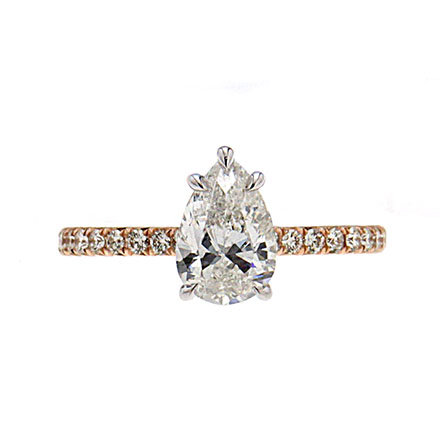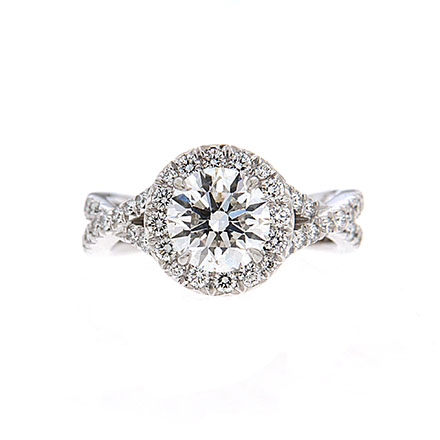The custom of wearing rings to mark an engagement is quite old, dating back thousands of years. Mounting diamonds onto engagement rings is another long tradition, with its roots in the early Renaissance. Today’s people still commemorate their weddings-to-be with bands, though the details are always changing.
While the first engagement rings are rumored to have started in ancient Egypt, they were first recorded elsewhere. Fiancées of the Roman Empire received two bands. They wore the iron ring when at home, and gold when they stepped outside. Both rings were placed on the worth finger of the left hand, said to have a vein which leads directly to the heart.
The first known diamond engagement ring was given in 1477. Archduke Maximillian of Austria used the jewel’s supreme hardness to symbolize unbreakable devotion for his betrothed, Mary of Burgundy. Those who could afford to were quick to emulate the Archduke, giving diamond engagement rings of their own. As diamonds became more available, the custom spread even further.
Today’s couples have a wide range of choices when it comes to their rings. Most still choose diamonds. There are many cuts to select, setting styles, and choice of precious metal. Some designs are timeless, such as a round solitaire diamond. Those that want something more unconventional can find or customize unique engagement rings. The limit is imagination.
Vintage Style Diamond Engagement Rings
 Jewelers are constantly innovating, trying to find new diamond engagement ring designs that appeal to couples. These can include variations on popular cuts, new embellishments and more ways to shape precious metal. Other approaches include updating previous styles, tweaking their beauty to appeal to current aesthetics. Those who enjoy a vintage touch may want to look at older designs.
Jewelers are constantly innovating, trying to find new diamond engagement ring designs that appeal to couples. These can include variations on popular cuts, new embellishments and more ways to shape precious metal. Other approaches include updating previous styles, tweaking their beauty to appeal to current aesthetics. Those who enjoy a vintage touch may want to look at older designs.
Edwardian style jewelry is recognized for its love of light colored metals, diamonds and openwork embellishments. Popular aesthetics included garlands, scrolls, lace and white on white. Those who want diamond engagement rings reminiscent of the Edwardian era might want to look at rings with marquise or cushion cut diamonds set in platinum or white gold. Open, delicate designs further emulate the period look.
Art Deco designs are categorized by bold colors and geometric lines. Diamond bands favored the sleek appearances of step cut stones such as baguettes, triangles, shields and emerald cuts. These jewels were used on their own, paired with gemstones of contrasting colors, or mounted to form stark designs. Today’s connoisseur may want to choose a ring with an emphasis on clean, dramatic lines.
The Retro period of jewelry design occurred between the 1930s and 1950s. Its most striking features were the use of colored gold, multihued designs, and whimsical imagery. Rings of the era favored bold statements such as diamonds in star settings, scrollwork and pave jewels. For a diamond band which emulates these styles, keep in mind rings featuring multicolored gold or curved designs.
Classic Diamond Engagement Rings
For some couples, timeless designs are the most comfortable. Part of the appeal of classic diamond engagement rings is connecting with tradition, of following in the footsteps of countless happily bonded people. Another appeal of tried and true styles is the idea of wearing a design that is less likely to turn old fashioned as the years pass.
Round brilliant diamonds made their debut in 1919. This cut provided then-unprecedented light in diamonds and has remained a popular stone ever since for all kinds of jewelry. Round brilliant cut diamond engagement rings remain the most sought after of engagement rings. Those who are unsure of what kind of ring they want may feel comfortable with a perennial favorite.
Before the advent of the round brilliant, cuts such as the old mine and old European were common. While they aimed to brighten the interior of the stone, they were also cut to preserve carat weight. The result is a sparking stone that sits between a square and a circle in shape. Those who want a classic look may want to consider cushion cut diamond engagement rings, their modern incarnation.
One style of engagement ring that debuted in the late 1880s features a single diamond prong mounted onto a plain band. The thin wires allow light to travel through the jewel, further drawing out brilliance and luster. This simple design has remained a favorite since its debut, and is a good choice for someone who wants an understated ring.
Bright Engagement Rings
 One of the primary appeals of diamonds is the way they interact with light. When cut just so, they sparkle with white and prismatic lights. A quality polish helps to bring out the jewel’s luster, or the reflection of light off of the stone’s surface. Many people looking for engagement rings favor a bright appearance, which can manifest in many ways.
One of the primary appeals of diamonds is the way they interact with light. When cut just so, they sparkle with white and prismatic lights. A quality polish helps to bring out the jewel’s luster, or the reflection of light off of the stone’s surface. Many people looking for engagement rings favor a bright appearance, which can manifest in many ways.
Princess cut diamonds were developed as a way to balance weight retention with promoting brilliance. It’s a mixed cut stone, with a short step cut upper and a substantial lower half cut to promote light reflection. Even though the cut is relatively young, premiering in the 1980s, it’s become a popular choice for jewelry. Those who want brilliance with an unconventional look often turn to princess cut engagement rings.
Round brilliant diamonds were developed after years of research to how light interacts with the stone. By adhering to careful ratios and proportions, diamonds could be made brighter than ever before. Their balance of brilliance, fire and scintillation make them the most popular of diamond cuts and a top choice for diamond engagement rings.
Pave settings get their name from the appearance of a ring paved in diamonds. This is accomplished by selecting tiny jewels of uniform size and carefully fitting them together on the band. Prongs may either be molded on or cut directly from precious metal; the overall impression is that of glitter and luster covering the ring. While this setting is often used to supplement a design, some rings are entirely pave.
Another source of shine is the polish of the precious metal. The finish can be as bright or subdued as the designer wishes. Even the more matte polishes can be made to reflect light in a subtle fashion, such as a gleam softened through brush marks or fine intersecting lines. A ring’s finish can be fashioned to highlight or contrast with the diamonds, adding to the jewel’s luster.





